
How Poisonous Plants Evolve to Survive: The Deadly Dance
admin
- 0
kfoodfair2015.com – In the intricate dance of life and survival, poisonous plants have evolved unique strategies to thrive in their environments. These plants, often feared for their toxic properties, have developed sophisticated mechanisms to deter herbivores and protect themselves from predation. This article explores the fascinating world of poisonous plants, examining their evolutionary strategies, physiological adaptations, and their role in the natural world.
Evolutionary Strategies
Poisonous plants have evolved various chemical defenses to protect themselves from herbivores. These defenses can be categorized into two main types: secondary metabolites and toxic compounds. Secondary metabolites are chemicals produced by plants that are not directly involved in their primary metabolic processes but serve as defense mechanisms. These can include alkaloids, terpenes, and phenols, which are often toxic to animals that consume them.
Physiological Adaptations
The physiological adaptations of poisonous plants are equally intriguing. Many of these plants have developed specialized structures that help them absorb and store toxic substances. For example, some plants have modified their roots to better absorb minerals and nutrients from the soil, which can include heavy metals that are toxic to other organisms.
Role in the Natural World
Despite their toxic nature, poisonous plants play a crucial role in the ecosystem. They are a vital source of food and shelter for many species, including insects and birds. Additionally, many poisonous plants have medicinal properties and are used in traditional medicine around the world. For instance, the digitalis plant, which contains the cardiac glycoside digoxin, is used in modern medicine to treat heart conditions.
Conclusion
The deadly dance of poisonous plants is a testament to the complexity of natural selection and the diverse strategies that plants have developed to survive. From their chemical defenses to their physiological adaptations, these plants are a fascinating example of how life evolves to thrive in challenging environments. As we continue to learn more about these plants, we gain a deeper appreciation for the intricate balance of nature and the role that all living organisms play in maintaining it.


